Experimental Study on Mixed Combustion Characteristics of Methanol/Diesel Pool Fires in Engine Rooms of Hybrid Ships
Abstract
:1. Introduction
2. Materials and Methods
2.1. Conditions Design
2.2. Design of Experimental System
3. Results
3.1. Combustion Phenomenon
- (I)
- Pure methanol combustion phase: As shown in Figure 5a, methanol, which has a lower density than diesel, floated on top of the fuel layer in the pool and ignited first. Upon ignition, methanol combustion exhibited a characteristic blue flame, primarily attributed to chemiluminescence from CO oxidation and the energy level transitions of free radical electrons, such as CH, C2, and CH2O [40]. This phase followed the initial combustion and fully developed stages commonly associated with methanol pool fires [41]. However, as the methanol flame continued to heat the underlying diesel layer, significant volumes of diesel vapor began to mix with the methanol flame during decay. Unlike the traditional methanol pool fire behavior, the decay and extinction stages in this experiment merged into a transitional combustion phase, leading to distinctive combustion phenomena.
- (II)
- Transitional combustion phase: As shown in Figure 5b, approximately 360 s into the experiment, the methanol layer approached depletion owing to continued combustion. At this stage, the heat generated is sufficient to evaporate the surface layer of the diesel, creating a combustible mixture with air. The pool fire temperature reached the point at which the mixture could ignite, leading to the emergence of fragmented yellow flames around and within the blue methanol flame. This phase marked the overlap between the decay stage of the methanol combustion and the initial growth stage of the diesel combustion. Over time, as the methanol supply diminished and more diesel vaporized, the yellow flame fragments became increasingly dominant within the blue flame, eventually resulting in the complete replacement of the blue flame with yellow or white flames.
- (III)
- Pure diesel combustion phase: As shown in Figure 5c, the pure diesel combustion phase begins after the transitional combustion phase once methanol is fully consumed, leaving only diesel in the pool. Diesel pool fires typically exhibit three stages: initial growth, stable combustion, and decay [44]. However, in this case, the initial growth phase of diesel combustion was integrated into the transitional combustion phase, leaving only stable combustion and decay stages. In the early part of this phase, the flame color remained primarily yellow−white due to the relatively low initial temperature of the diesel combustion, which resulted in incomplete combustion. As the process continued, the temperature of the diesel increased, releasing substantial amounts of vaporized gases, leading to more complete combustion and the appearance of a predominantly orange−yellow flame [45]. Compared with the transitional combustion phase, the flame exhibited reduced brightness, and both the oscillation frequency and amplitude were significantly lower. Combustion remained stable until the diesel was fully consumed, at which point the flame was extinguished.
3.2. Mass Loss Rate
3.2.1. Mass and Mass Loss Rate Curves
3.2.2. Quantitative Analysis of Slopover Intensity
3.3. Flame Height
3.4. Heat Transfer Model
3.4.1. Centerline Temperature Within the Fuel Layer
3.4.2. Heat Feedback
3.4.3. Prediction of Burning Rate
3.4.4. Causes of Slopover
- (I).
- Regarding heat transfer, the heat transferred to diesel through both heat conduction and thermal radiation directly influenced the intensity of slopover. From the perspective of heat conduction, liquid methanol could be regarded as a thermal resistance, expressed as:
- (II).
- From the perspective of evaporation rate and vapor pressure dynamics, the diesel vapor pressure needs to overcome both the hydrostatic pressure of the diesel column and the surface tension of the vapor bubble itself to propel ignited droplets out of the pool, expressed as:
- (III).
- From the perspective of turbulent combustion, based on the ideal gas equation of state, can be expressed in an alternative form different from Equation (35), given as:
4. Conclusions
- (I).
- The combustion process of a pool fire was divided into three phases: the pure methanol combustion phase, the transitional combustion phase, and the pure diesel combustion phase, with slopover most likely occurring during the transitional combustion phase. The frequency and intensity of slopover were directly related to the pool diameter and the amount of methanol fuel. Under the same methanol thickness, an increase in pool diameter significantly reduced both the occurrence and intensity of slopover, while under the same pool diameter, a greater methanol fuel amount also led to a noticeable decrease in slopover events. When the methanol layer reached a certain thickness, slopover did not occur at all. Based on this conclusion, a quantitative analysis was conducted to establish the mathematical relationship between slopover intensity, pool diameter, and the methanol/diesel volume ratio. Quantitative relationships have indicated a coupled effect between the pool diameter and the methanol/diesel volume ratio on slopover intensity, with the influence of pool diameter being more significant than that of the volume ratio.
- (II).
- During the transitional combustion phase, the flame height was influenced by multiple variables rather than a single factor. By applying the Thomas method to predict the flame height based on the mass burning rate, a multivariable function model was developed to establish a correlation between the average flame height, fuel volume ratio, and pool diameter.
- (III).
- Through thermal feedback analysis, a multivariable correction function incorporating the pool diameter and methanol/diesel volume ratio was integrated into the burning rate model for the transitional combustion phase. The correction function assists in more precisely forecasting the burning rate of methanol/diesel pool fire during the transitional combustion phase.
- (IV).
- From the perspective of internal heat transfer and fire dynamics, slopover in immiscible methanol/diesel pool fires results from the coupling of multiple physical fields rather than a single factor. A thicker methanol layer increases the internal thermal resistance, delaying heat transfer to the diesel and reducing the surface temperature gradient, which inhibits diesel evaporation and suppresses slopover. Dynamically, slopover occurs only when the transient vapor overpressure exceeds the combined hydrostatic pressure and surface tension. Thicker methanol slows diesel heating and vapor accumulation, making this threshold harder to reach. Additionally, the turbulent environment in large−diameter pool fires enhances vapor diffusion, further lowering local vapor pressure. Thus, both increased methanol thickness and larger pool diameter reduce slopover intensity by altering heat transfer and evaporation–combustion coupling. This also explains the strong correlation between the correction factor K in the transitional burning rate model and the dimensionless pool diameter and fuel volume ratio.
Author Contributions
Funding
Data Availability Statement
Conflicts of Interest
References
- Zincir, B.; Deniz, C.; Tunér, M. Investigation of environmental, operational and economic performance of methanol partially premixed combustion at slow speed operation of a marine engine. J. Clean. Prod. 2019, 235, 1006–1019. [Google Scholar] [CrossRef]
- Toscano, D.; Murena, F. Atmospheric ship emissions in ports: A review. Correlation with data of ship traffic. Atmos. Environ. X 2019, 4, 100050. [Google Scholar] [CrossRef]
- Fourth Greenhouse Gas Study 2020. Available online: https://www.imo.org/en/ourwork/Environment/Pages/Fourth-IMO-Greenhouse-Gas-Study-2020.aspx (accessed on 9 April 2025).
- Shi, Z.; Endres, S.; Rutgersson, A.; Al-Hajjaji, S.; Brynolf, S.; Booge, D.; Hassellöv, I.-M.; Kontovas, C.; Kumar, R.; Liu, H.; et al. Perspectives on shipping emissions and their impacts on the surface ocean and lower atmosphere: An environmental-social-economic dimension. Elem. Sci. Anth. 2023, 11, 00052. [Google Scholar] [CrossRef]
- Joung, T.-H.; Kang, S.-G.; Lee, J.-K.; Ahn, J. The IMO initial strategy for reducing Greenhouse Gas (GHG) emissions, and its follow-up actions towards 2050. J. Int. Marit. Saf. Environ. Aff. Shipp. 2020, 4, 1–7. [Google Scholar] [CrossRef]
- Çelik, M.B.; Özdalyan, B.; Alkan, F. The use of pure methanol as fuel at high compression ratio in a single cylinder gasoline engine. Fuel 2011, 90, 1591–1598. [Google Scholar] [CrossRef]
- Zhen, X.; Wang, Y. Numerical analysis on original emissions for a spark ignition methanol engine based on detailed chemical kinetics. Renew. Energy 2015, 81, 43–51. [Google Scholar] [CrossRef]
- Tanaka, T.; Tabata, M. Effect of Equivalence Ratio on NO Distribution Inside a Spark Ignition Engine by Using Laser-Induced-Fluorescence Method. JSME Int. J. Ser. B 1999, 42, 262–267. [Google Scholar] [CrossRef]
- Gong, C.; Yi, L.; Zhang, Z.; Sun, J.; Liu, F. Assessment of ultra-lean burn characteristics for a stratified-charge direct-injection spark-ignition methanol engine under different high compression ratios. Appl. Energy 2020, 261, 114478. [Google Scholar] [CrossRef]
- Chen, Z.; He, J.; Chen, H.; Geng, L.; Zhang, P. Experimental study on cycle-to-cycle variations in natural gas/methanol bi-fueled engine under excess air/fuel ratio at 1.6. Energy 2021, 224, 120233. [Google Scholar] [CrossRef]
- Zheng, F.; Cho, H.M. Exploring the Effects of Synergistic Combustion of Alcohols and Biodiesel on Combustion Performance and Emissions of Diesel Engines: A Review. Energies 2024, 17, 6274. [Google Scholar] [CrossRef]
- Methanol Dual-Fuel Two-Stroke Engine. Available online: https://www.man-es.com/discover/antonia-maersk-methanol-ship (accessed on 25 November 2024).
- Habibic, A. Caterpillar Marine Aims to Deploy Methanol Dual-Fuel Marine Engines in 2026; Offshore Energy: Schiedam, The Netherlands, 2024. [Google Scholar]
- Jin, Y.; Zhang, Y.; Dong, P.; Zhai, C.; Nishida, K.; Wang, Y.; Leng, X. Diesel spray characteristics of multi-hole injectors under geometrical similarity condition. At. Sprays 2025, 35, 19–45. [Google Scholar] [CrossRef]
- Chu, W.; Li, H.; Liu, Y.; Zhou, B.; Luo, H.; Kim, W. Three-dimensional simulation analysis of in-cylinder combustion in space in-orbit hydrogen–oxygen internal combustion engine. Appl. Therm. Eng. 2025, 263, 125391. [Google Scholar] [CrossRef]
- Chang, F.; Luo, H.; Zhai, C.; Jin, Y.; Xiong, P.; Wang, J.; Song, B.; Zhang, J.; Nishida, K. Experimental investigation of fuel adhesion from wall-impinging spray with various injection mass ratios. Exp. Therm. Fluid Sci. 2025, 163, 111403. [Google Scholar] [CrossRef]
- Liang, J.; Wang, A.; Feng, Y.; Li, X.; Hu, Y.; Dong, S.; Zhang, Y.; Zhao, F. An Experimental and Kinetic Modeling Study of the Laminar Burning Velocities of Ammonia/n-Heptane Blends. Energies 2024, 17, 4874. [Google Scholar] [CrossRef]
- Díaz-Secades, L.A.; González, R.; Rivera, N. Waste heat recovery from marine main medium speed engine block. Energy, exergy, economic and environmental (4E) assessment—Case study. Ocean Eng. 2022, 264, 112493. [Google Scholar] [CrossRef]
- Miao, Z.; Wenhua, S.; Ji, W.; Zhen, C. Accident Consequence Simulation Analysis of Pool Fire in Fire Dike. Procedia Eng. 2014, 84, 565–577. [Google Scholar] [CrossRef]
- Bonte, F.; Noterman, N.; Merci, B. Computer simulations to study interaction between burning rates and pressure variations in confined enclosure fires. Fire Saf. J. 2013, 62, 125–143. [Google Scholar] [CrossRef]
- Chen, J.; Bi, Y.; Zhao, Y.; Tam, W.C.; Li, C.; Lu, S. Effect of pressure on the heat transfer of pool fire in a closed chamber. J. Therm. Anal. Calorim. 2020, 142, 2163–2171. [Google Scholar] [CrossRef]
- Hostikka, S.; Janardhan, R.K.; Riaz, U.; Sikanen, T. Fire-induced pressure and smoke spreading in mechanically ventilated buildings with air-tight envelopes. Fire Saf. J. 2017, 91, 380–388. [Google Scholar] [CrossRef]
- He, Q.; Li, C.; Lu, S.; Huang, S. Experimental Study of Pool Fire Burning Behaviors in Ceiling Vented Ship Cabins. Procedia Eng. 2014, 71, 462–469. [Google Scholar] [CrossRef]
- Kota, S.B.; Subramani, A.; Jayanti, S. Auto-ignition temperature and burning rate of potassium pool fire in a confined enclosure. Combust. Flame 2016, 168, 286–295. [Google Scholar] [CrossRef]
- Babrauskas, V. Estimating large pool fire burning rates. Fire Technol. 1983, 19, 251–261. [Google Scholar] [CrossRef]
- Diffusion Burning of Liquids. Available online: https://apps.dtic.mil/sti/citations/tr/AD0296762 (accessed on 11 May 2024).
- Hamins, A.P.; Kashiwagi, T.; Buch, R. Characteristics of Pool Fire Burning; NIST: Gaithersburg, MD, USA, 1995.
- Tian, X.; Liu, C.; Zhong, M.; Shi, C. Experimental study and theoretical analysis on influencing factors of burning rate of methanol pool fire. Fuel 2020, 269, 117467. [Google Scholar] [CrossRef]
- Sung, K.; Chen, J.; Bundy, M.; Hamins, A. The characteristics of a 1 m methanol pool fire. Fire Saf. J. 2021, 120, 103121. [Google Scholar] [CrossRef]
- Vali, A.; Nobes, D.S.; Kostiuk, L.W. Transport phenomena within the liquid phase of a laboratory-scale circular methanol pool fire. Combust. Flame 2014, 161, 1076–1084. [Google Scholar] [CrossRef]
- Yuan, J.; Zhao, J.; Wang, W.; Yang, R.; Chen, C.; Fu, M. The study of burning behaviors and quantitative risk assessment for 0# diesel oil pool fires. J. Loss Prev. Process Ind. 2021, 72, 104568. [Google Scholar] [CrossRef]
- Yang, S.; Pu, F.; Zhang, L.; Li, M.; Li, J. Experimental study on combustion characteristics of water-in-oil emulsified diesel pool fire with water sublayer. Appl. Therm. Eng. 2024, 238, 121932. [Google Scholar] [CrossRef]
- Zhao, J.; Zhang, Q.; Hu, Z.; Kang, R.; Jomaas, G.; Yang, R. Thin-layer boilover of large-scale diesel pool fires at sub-atmospheric pressure. Fuel 2024, 360, 130482. [Google Scholar] [CrossRef]
- Yip, A.; Haelssig, J.B.; Pegg, M.J. Multicomponent pool fires: Trends in burning rate, flame height, and flame temperature. Fuel 2021, 284, 118913. [Google Scholar] [CrossRef]
- Ding, Y.; Wang, C.; Lu, S. The effect of azeotropism on combustion characteristics of blended fuel pool fire. J. Hazard. Mater. 2014, 271, 82–88. [Google Scholar] [CrossRef]
- Zhu, P.; Huang, S.P.; Liu, Q.Y.; Zhu, X.L.; Shao, Q. Effects of low ambient pressure on the flame characteristics of ethanol-gasoline blended pool fire. Fuel 2024, 362, 130809. [Google Scholar] [CrossRef]
- Gao, Z.; Wan, H.; Ji, J. The effect of blend ratio on the combustion process of mutually stratified blended fuels pool fire. Proc. Combust. Inst. 2021, 38, 4995–5003. [Google Scholar] [CrossRef]
- Richards, P.; Baker, J. Automotive Fuels Reference Book, 4th ed.; SAE International: Warrendale, PA, USA, 2023; ISBN 978-1-4686-0578-5. [Google Scholar]
- Yaws, C.L. Thermophysical Properties of Chemicals and Hydrocarbons; William Andrew: Norwich, NY, USA, 2008; ISBN 978-0-8155-1990-4. [Google Scholar]
- Hwang, W.; Dec, J.; Sjöberg, M. Spectroscopic and chemical-kinetic analysis of the phases of HCCI autoignition and combustion for single- and two-stage ignition fuels. Combust. Flame 2008, 154, 387–409. [Google Scholar] [CrossRef]
- Vali, A.; Nobes, D.S.; Kostiuk, L.W. Quantifying the Conduction Pathways in a Laboratory-Scale Methanol Pool Fire. Combust. Sci. Technol. 2015, 187, 765–779. [Google Scholar] [CrossRef]
- Jarosz, W. Boilover and slopover phenomena during a fire of storage tanks containing crude oil. Zesz. Nauk. SGSP/Szkoła Główna Służby Pożarniczej 2011, 42, 15–22. [Google Scholar]
- Gülder, Ö.L. Transport of water vapor from combustion gases into liquid-phase in unsteady methanol pool flames. Exp. Therm. Fluid Sci. 2000, 23, 51–57. [Google Scholar] [CrossRef]
- Wang, J.; Cui, X.; Zhang, R.; Xie, Q.; Zhang, S.; Shi, L. Study on the mass loss rate of liquid pool fire in a well-confined ship cabin. Int. J. Therm. Sci. 2021, 166, 106984. [Google Scholar] [CrossRef]
- Ferrero, F.; Muñoz, M.; Arnaldos, J. Thin-layer boilover in diesel-oil fires: Determining the increase of thermal hazards and safety distances. J. Hazard. Mater. 2007, 140, 361–368. [Google Scholar] [CrossRef]
- Zukoski, E.E. Visible structure of buoyant diffusion flames. Symp. Combust. 1985, 20, 361–366. [Google Scholar] [CrossRef]
- Maynard, T.B.; Butta, J.W. A Physical Model for Flame Height Intermittency. Fire Technol. 2018, 54, 135–161. [Google Scholar] [CrossRef]
- Heskestad, G. Fire plumes, flame height, and air entrainment. In SFPE Handbook of Fire Protection Engineering; Hurley, M.J., Gottuk, D., Hall, J.R., Harada, K., Kuligowski, E., Puchovsky, M., Eds.; Springer: New York, NY, USA, 2016; pp. 396–428. [Google Scholar]
- Thomas, P.H. The size of flames from natural fires. Symp. Int. Combust. 1963, 9, 844–859. [Google Scholar] [CrossRef]
- Hottel, H.C. Certain laws governing the diffusive burning of liquids–A review. Fire Res. Abs. Rev. 1959, 1, 41–44. [Google Scholar]
- Vali, A. Investigation of the Transport Phenomena within the Liquid Phase of a Methanol Pool Fire. Available online: https://era.library.ualberta.ca/items/946cf7b5-28d8-4ef4-819f-7961d8b0192a (accessed on 28 September 2024).
- Baranova, T.; Zhukova, Y.V.; Chorny, A.D.; Trekh, A.; Rudenko, A.I. Convective heat transfer of heat sinks with partially cut plate fins and turning of their cut sections. Heat Transf. Res. 2023, 54, 17–28. [Google Scholar] [CrossRef]
- Modak, A.T.; Croce, P.A. Plastic Pool Fires. Combust Flame 1977, 30, 251–265. [Google Scholar] [CrossRef]
- Wang, X.; Zhou, K.; Mebarki, A.; Jiang, J. Numerical simulation of thermal response behavior of floating-roof tanks exposed to pool fire. Appl. Therm. Eng. 2020, 179, 115692. [Google Scholar] [CrossRef]
- Hu, L.; Tang, F.; Wang, Q.; Qiu, Z. Burning characteristics of conduction-controlled rectangular hydrocarbon pool fires in a reduced pressure atmosphere at high altitude in Tibet. Fuel 2013, 111, 298–304. [Google Scholar] [CrossRef]
- Tien, C.; Sc, L. Flame radiation. Prog. Energy Combust Sci. 1982, 8, 41–59. [Google Scholar] [CrossRef]
- Yi, L.; Wang, X.; Bu, R.; Zhang, S.; Zhou, Y. A Methodology for Predicting Temperature Distribution inside Concrete Pavement under A Pool Fire. Combust. Sci. Technol. 2021, 193, 911–930. [Google Scholar] [CrossRef]
- Hamins, A.P.; Yang, J.C.; Kashiwagi, T. Global Model for Predicting the Burning Rates of Liquid Pool Fires (NISTIR 6381); NIST: Gaithersburg, MD, USA, 1999.
- Hamins, A.; Fischer, S.J.; Kashiwagi, T.; Klassen, M.E.; Gore, J.P. Heat Feedback to the Fuel Surface in Pool Fires. Combust. Sci. Technol. 1994, 97, 37–62. [Google Scholar] [CrossRef]
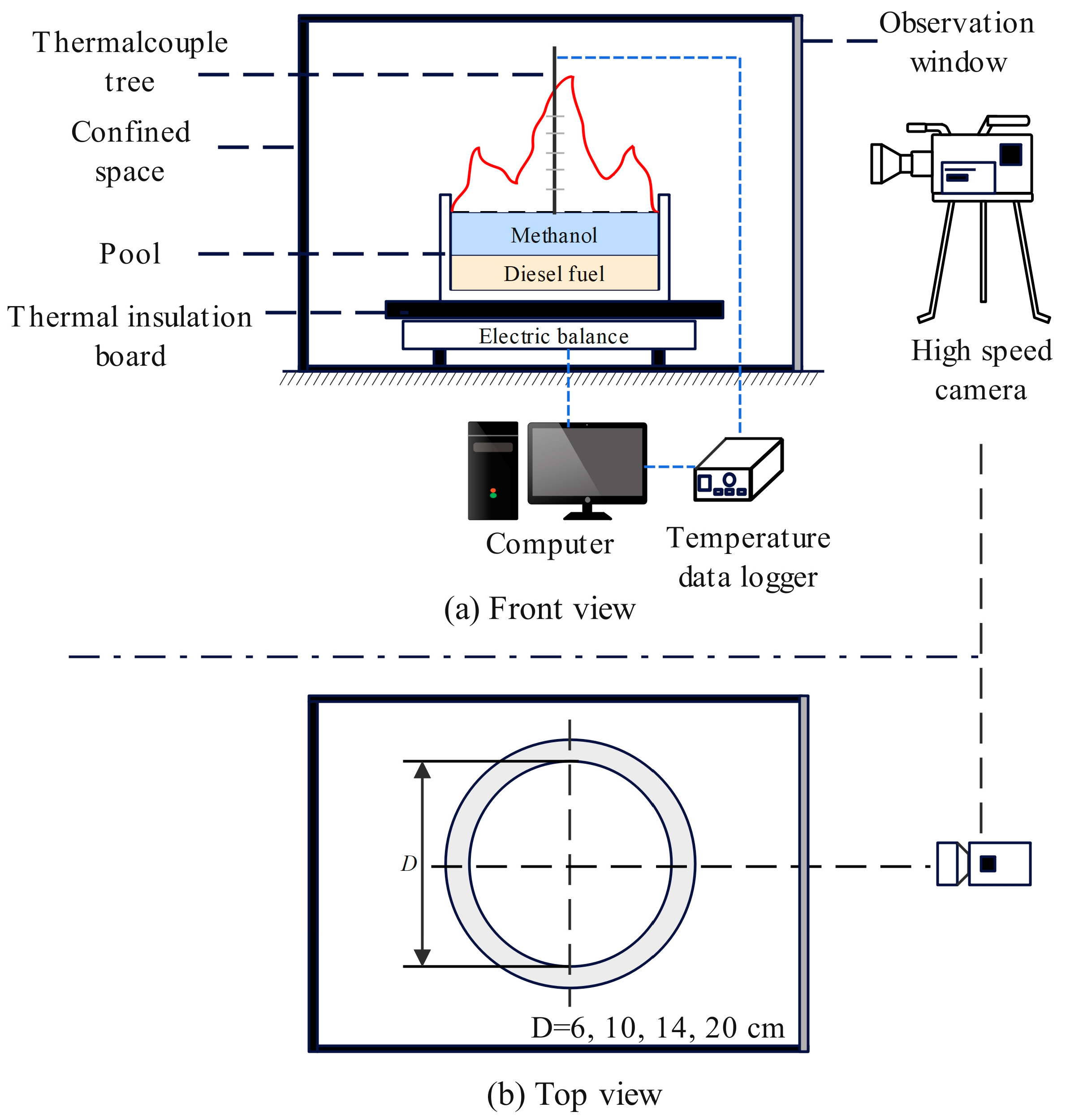
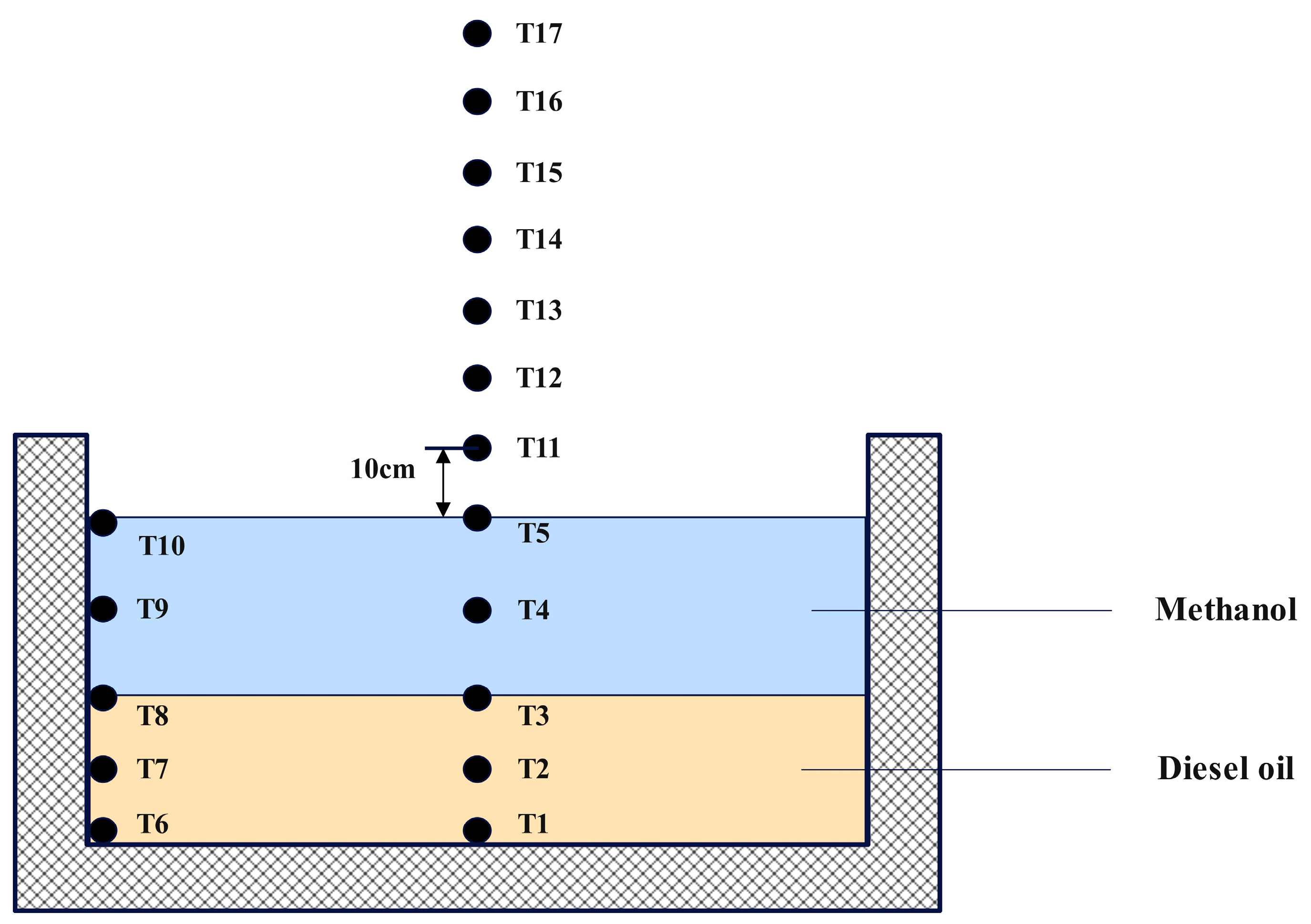

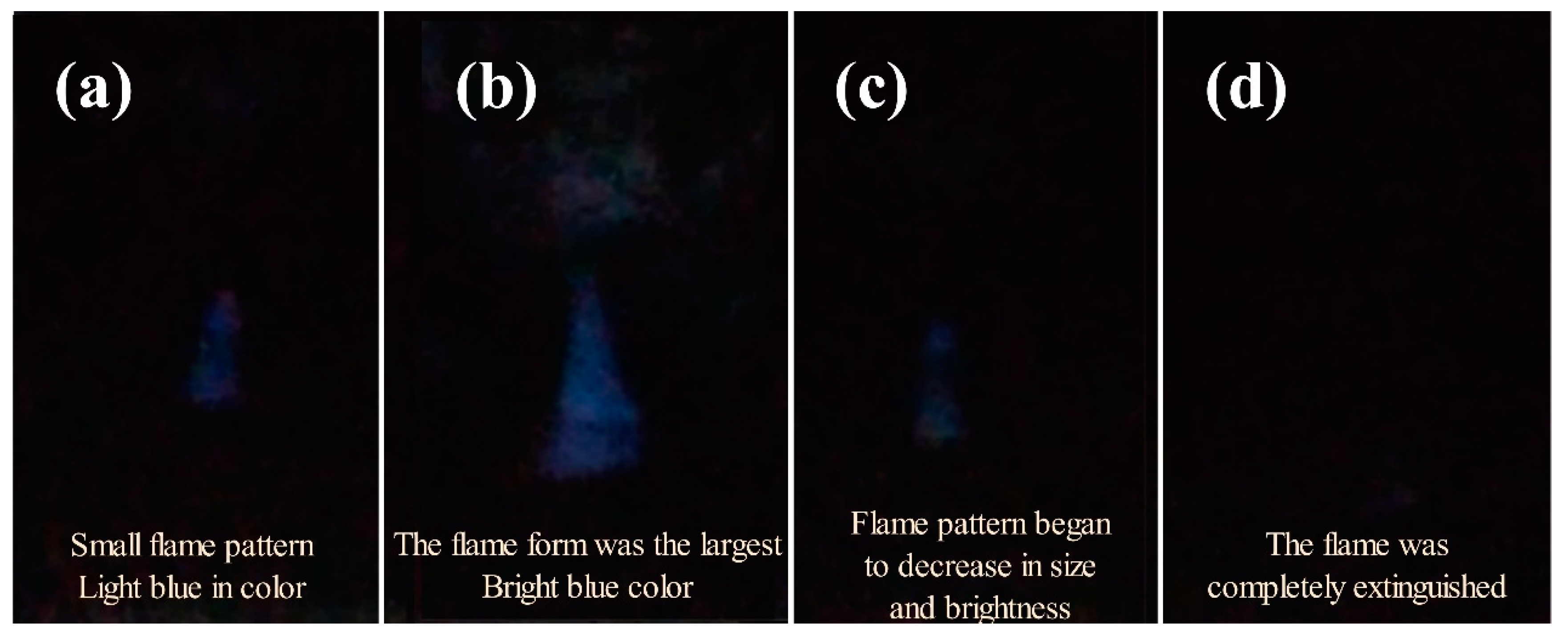

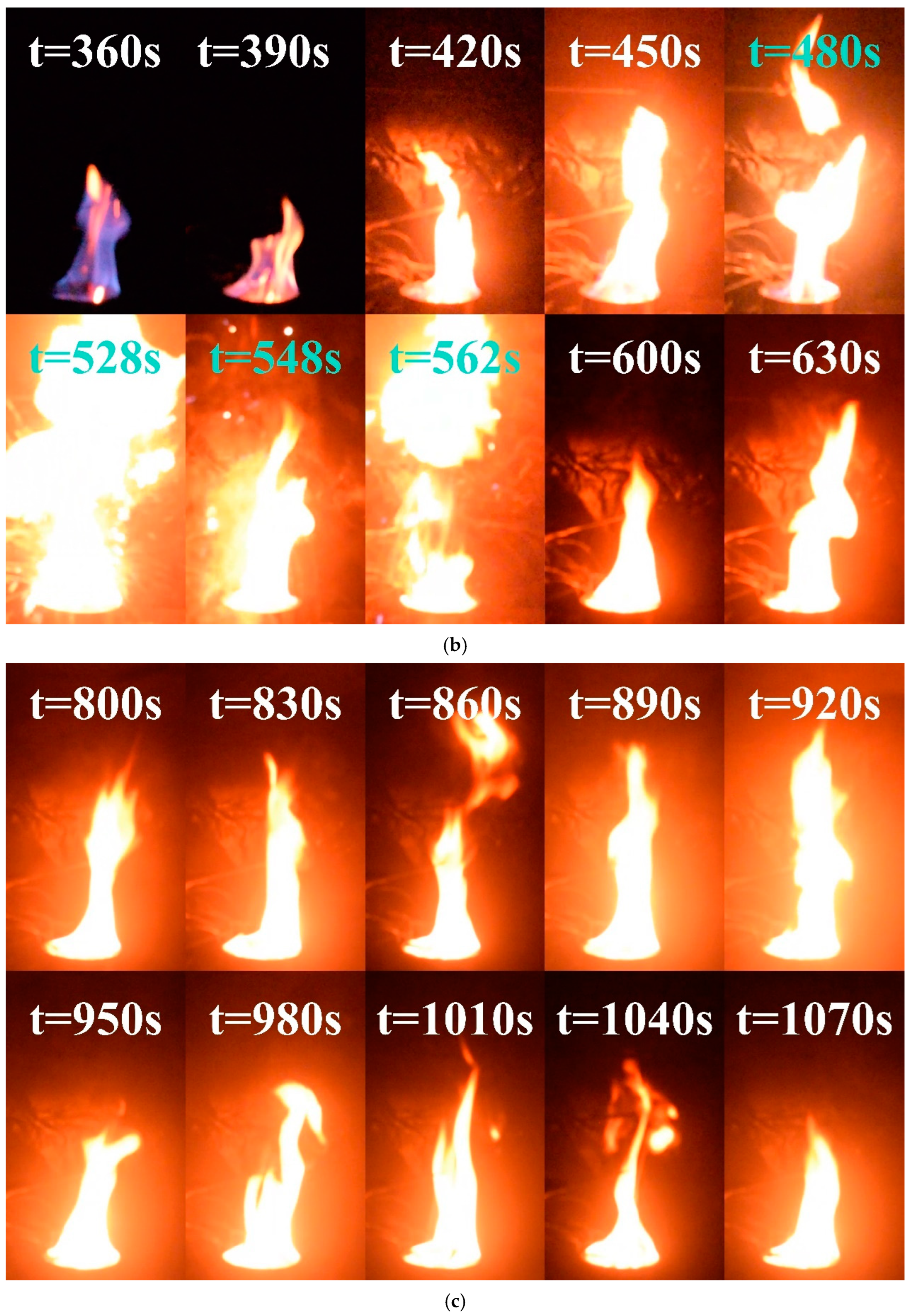
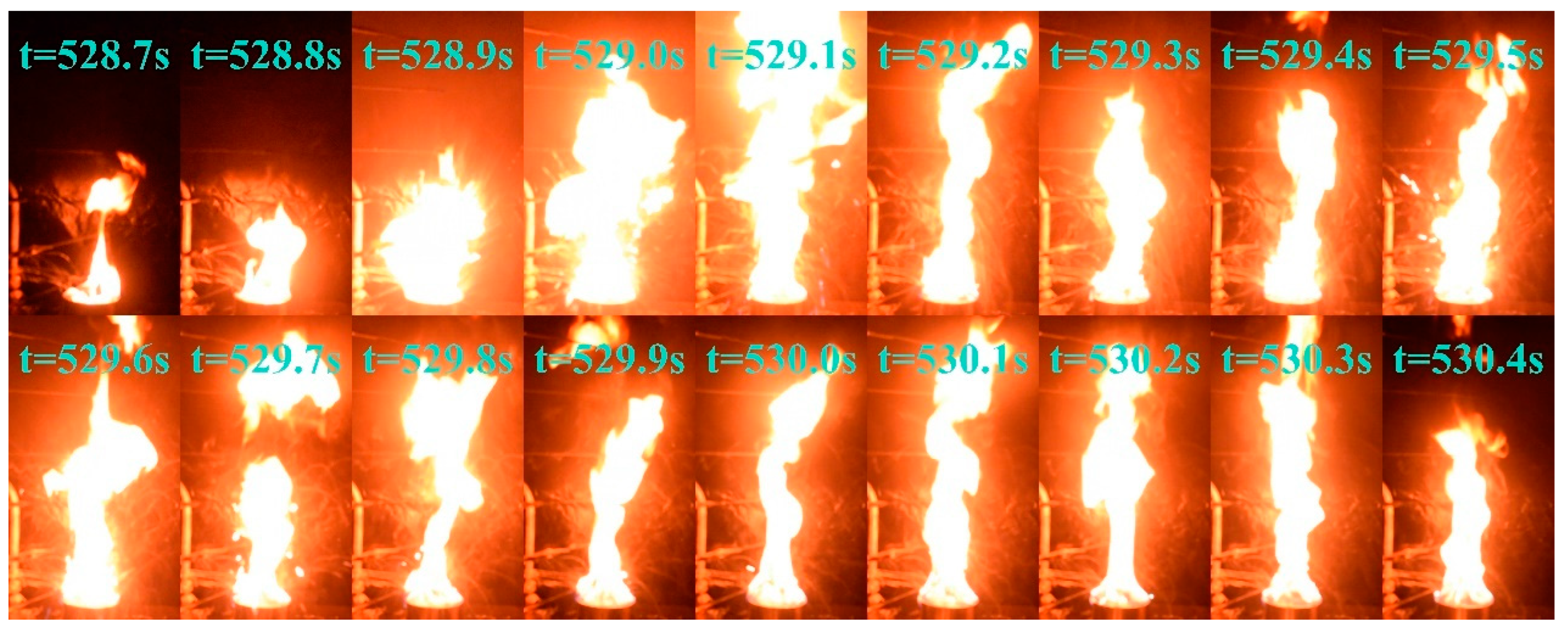
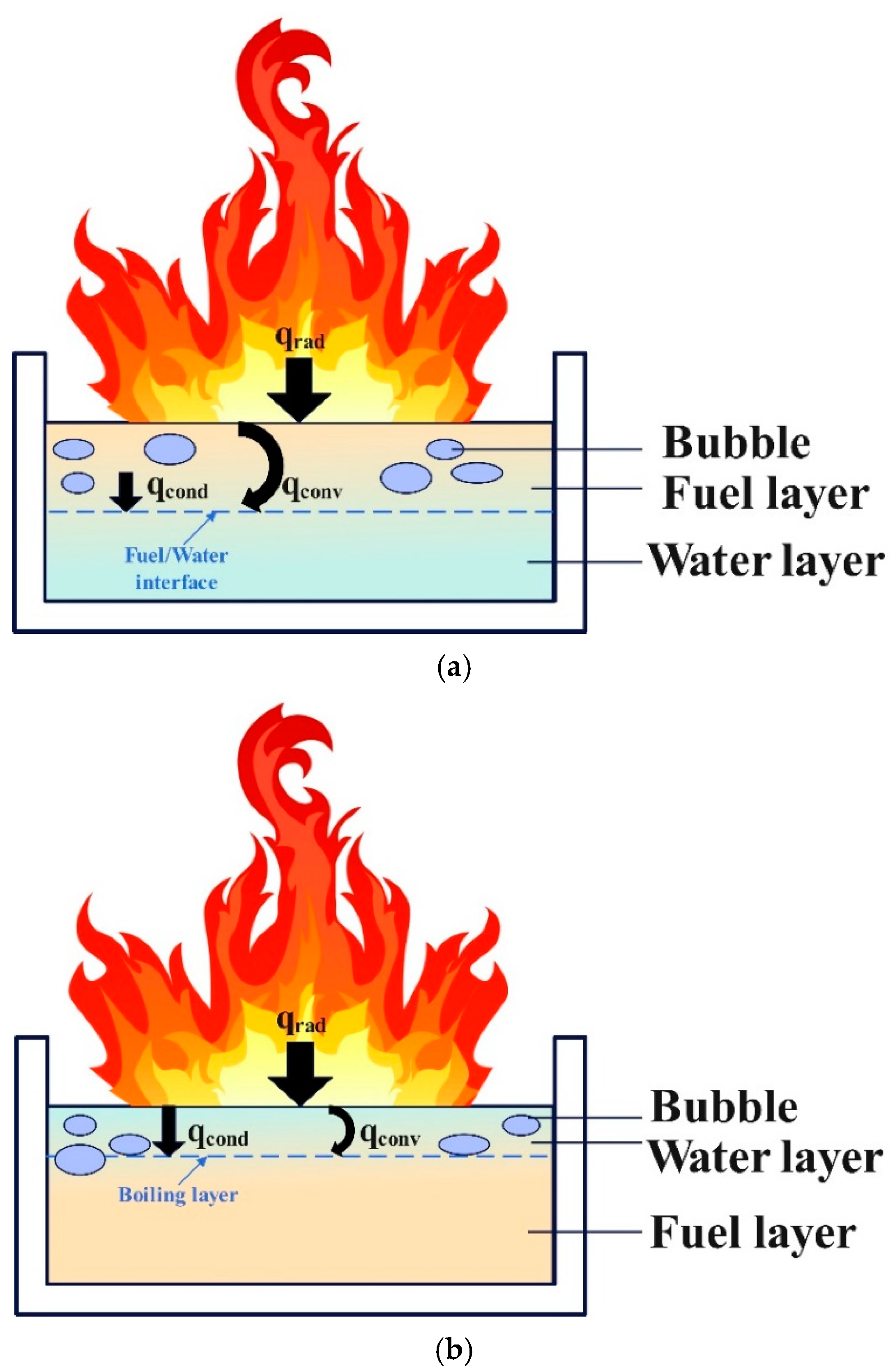

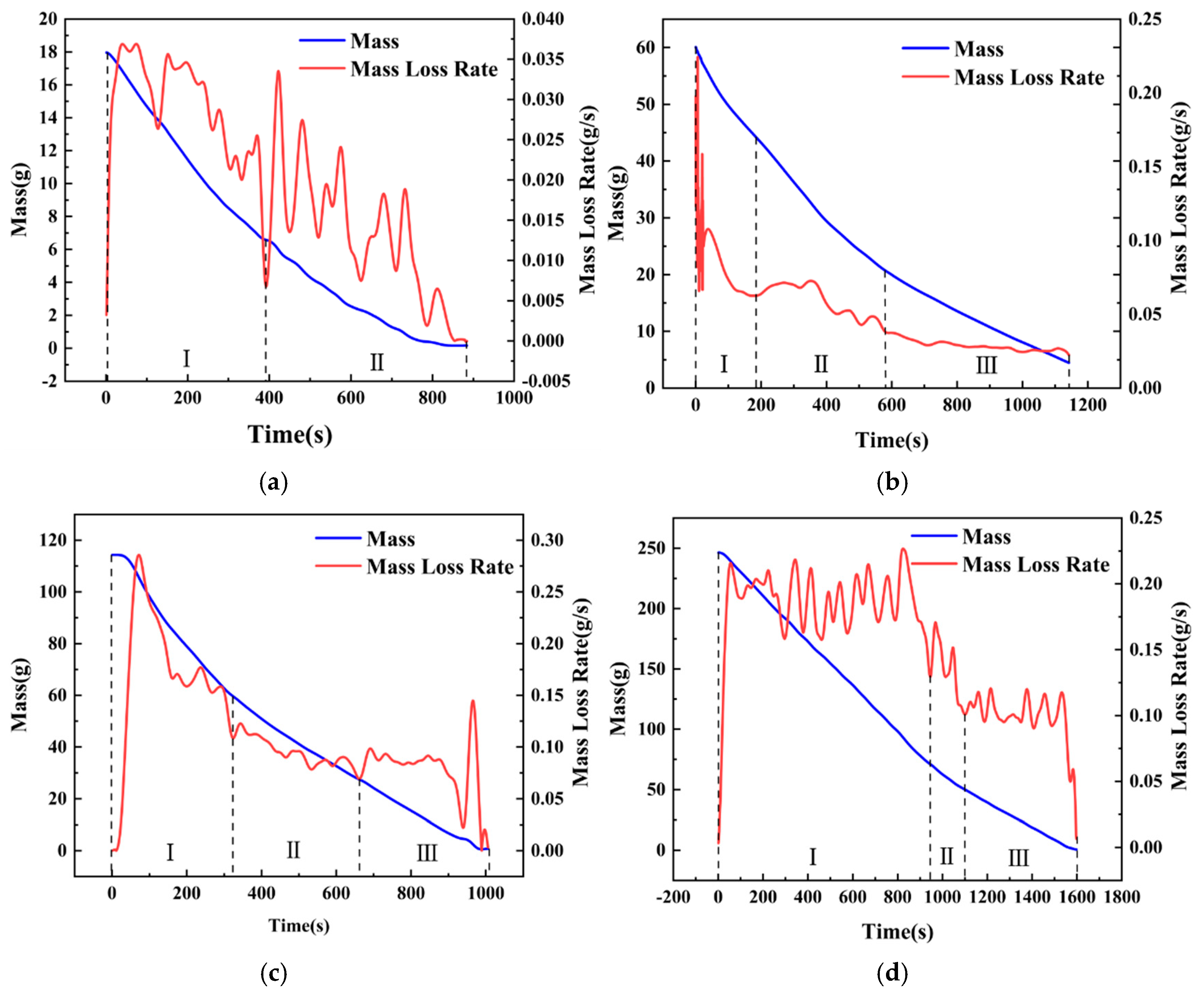
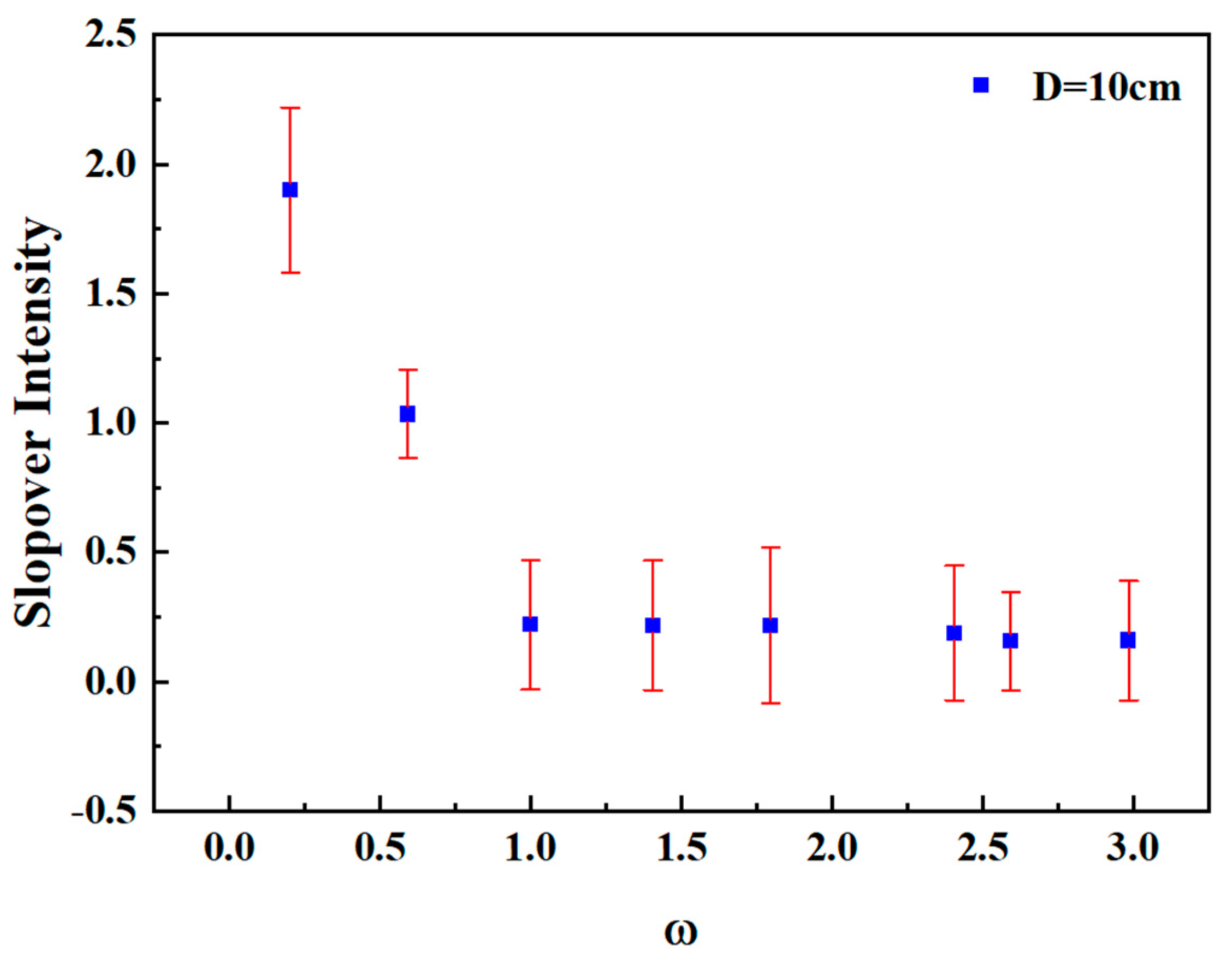



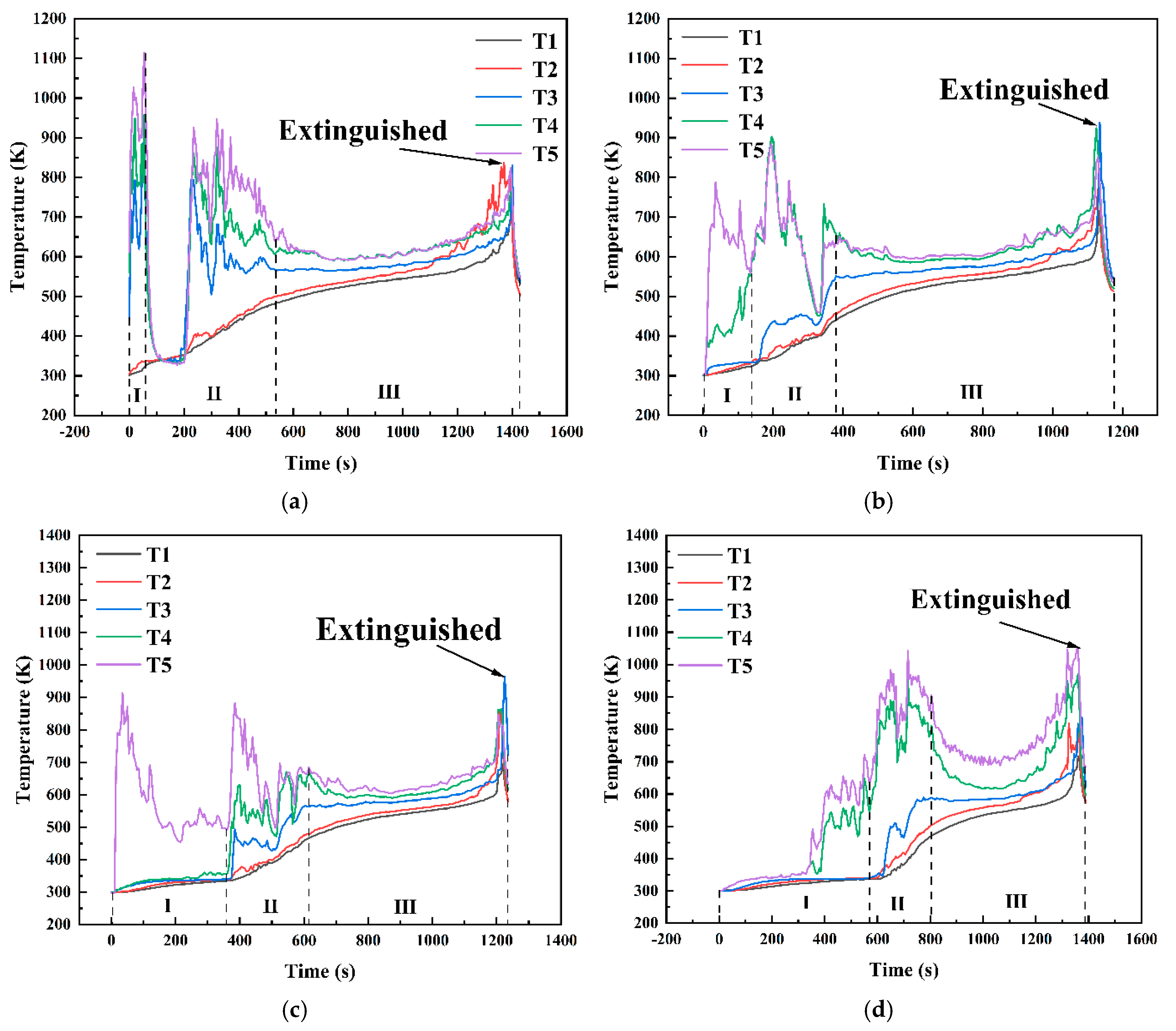
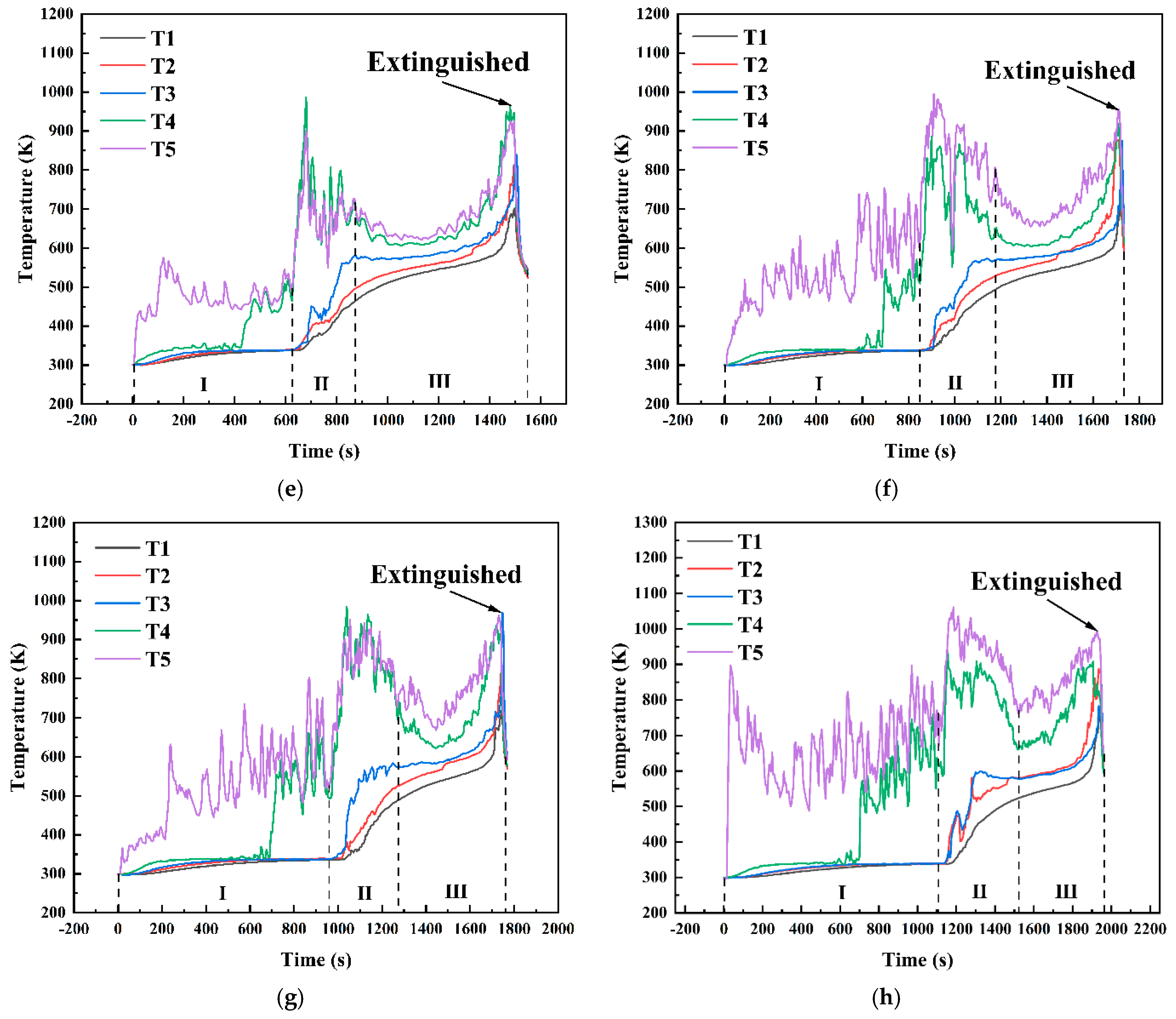
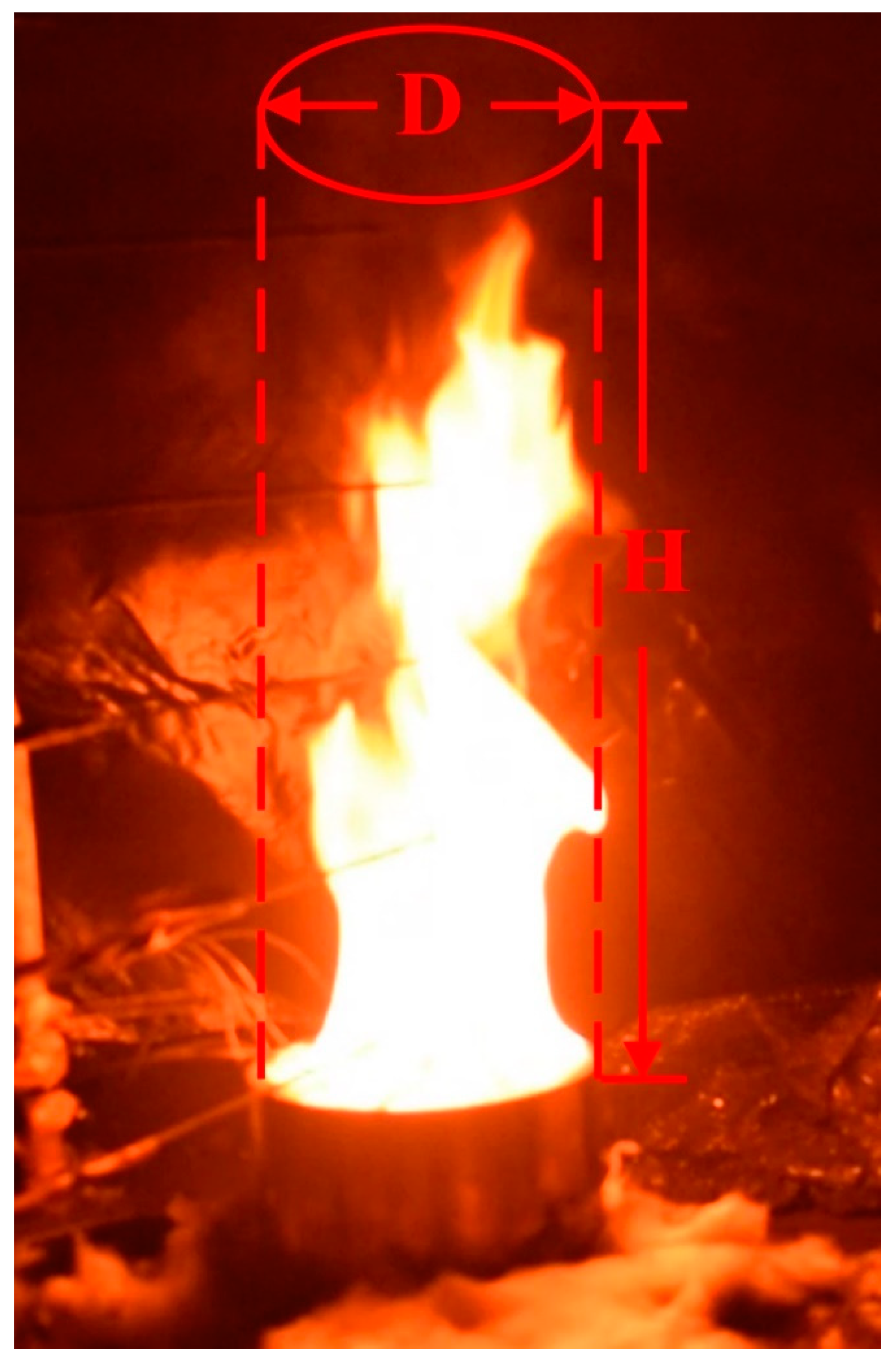

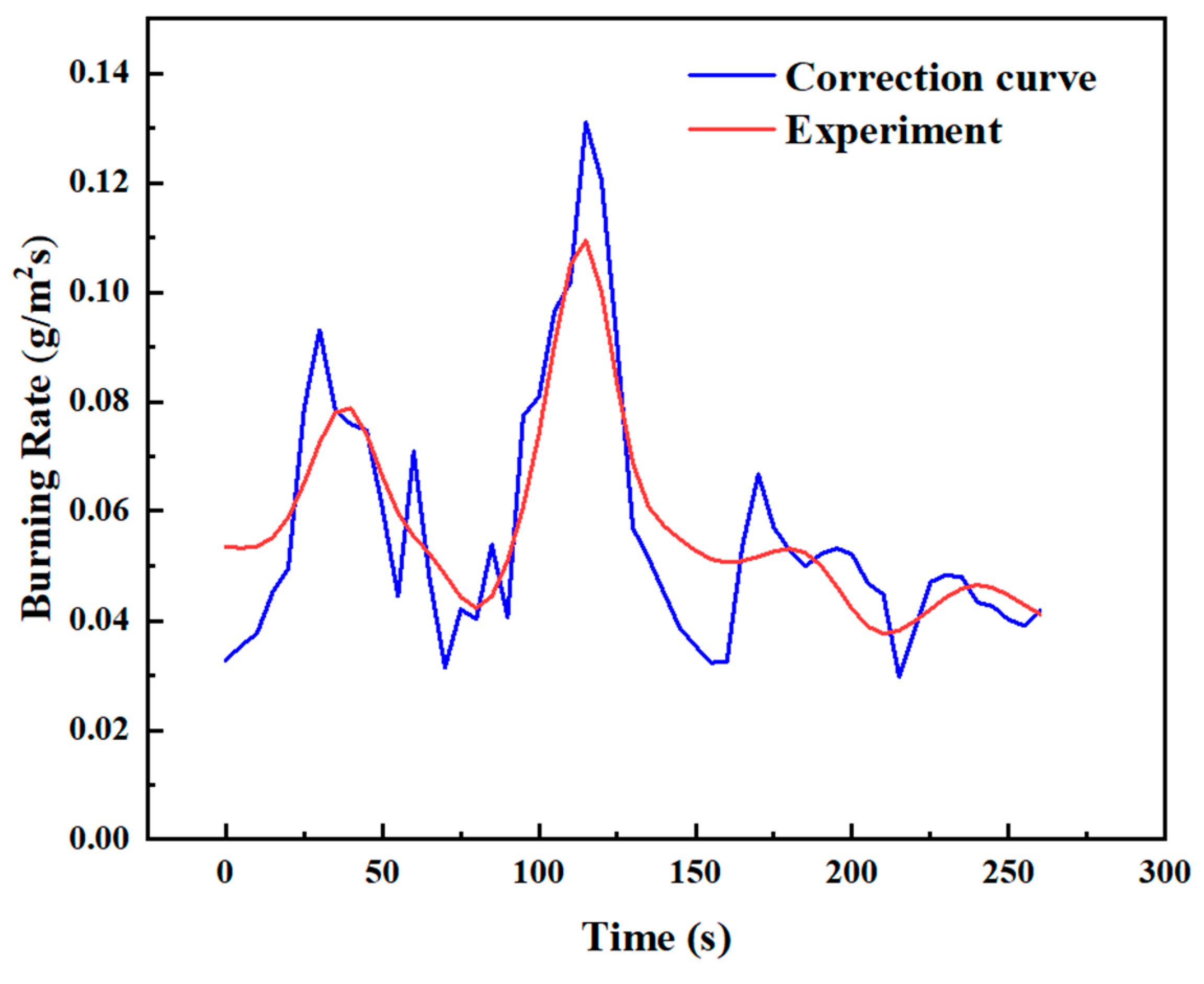
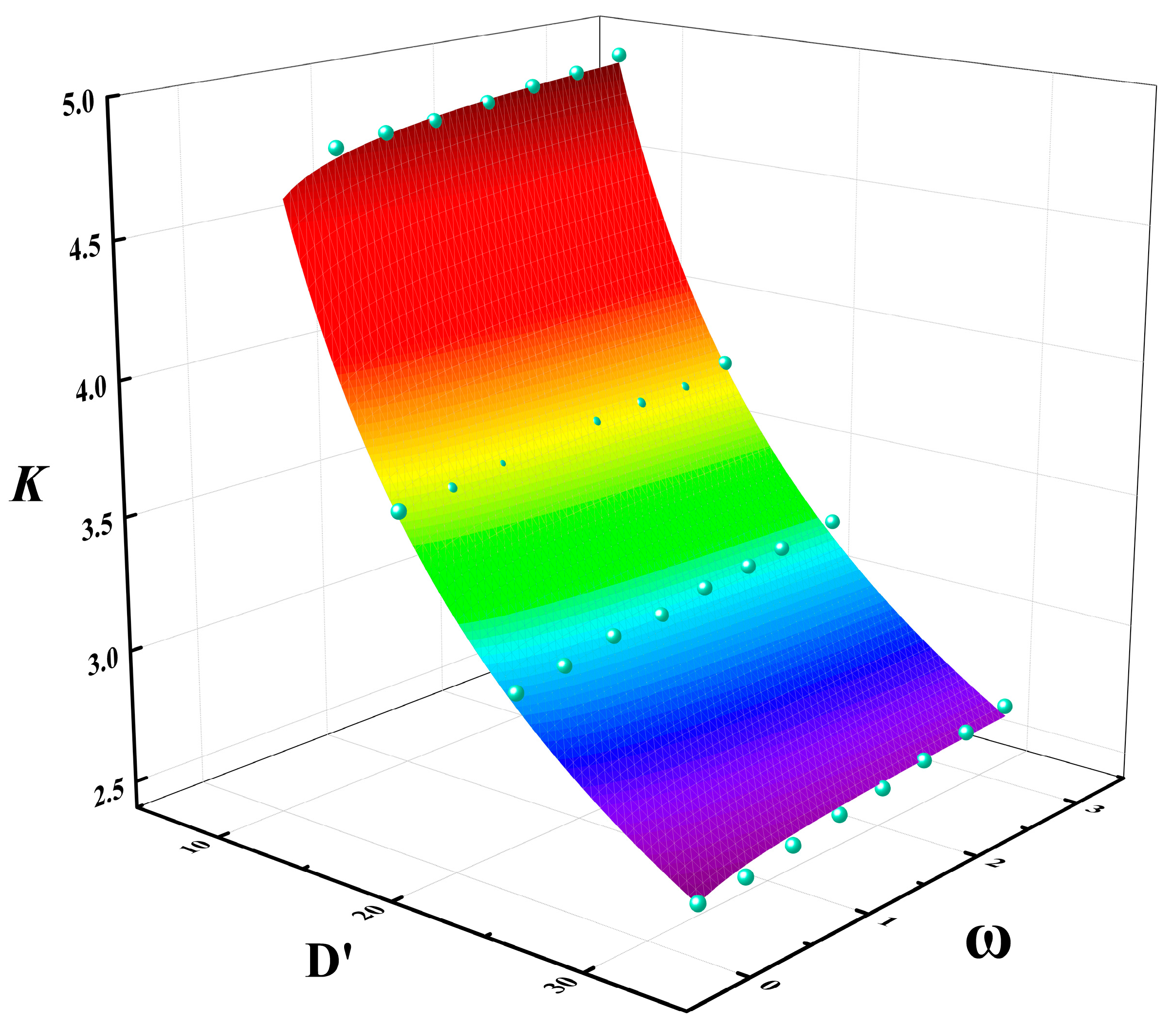
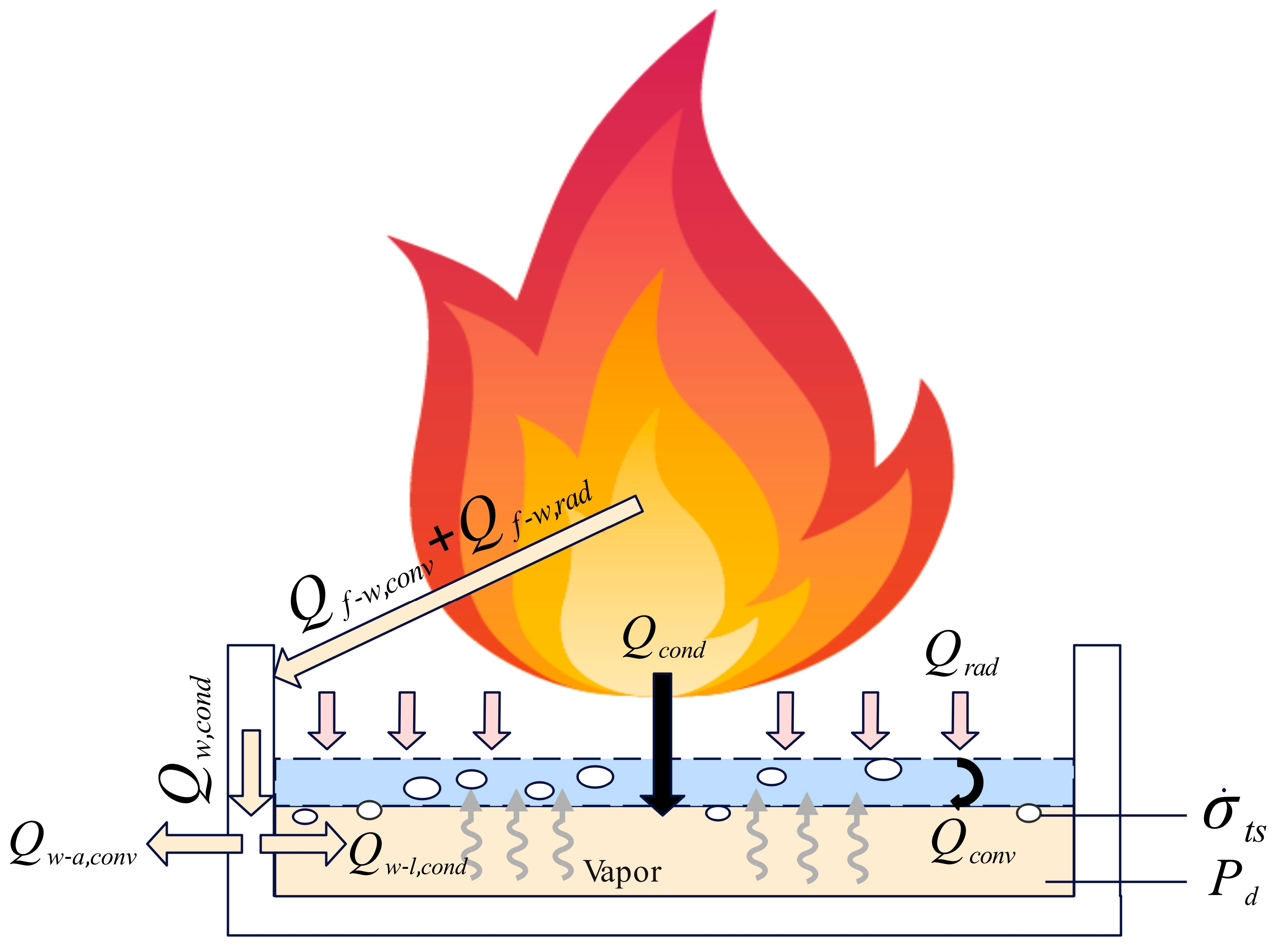
| Fuel | Molecular Weight | Density (g/cm3) | Boiling Point (°C) | Heat of Vaporization (MJ/kg) | Heat of Combustion (MJ/kg) |
|---|---|---|---|---|---|
| Methanol | 32 | 0.79 | 64.7 | 1.11 | 20 |
| Diesel | 200 | 0.835 | 350 | 260 | 44.8 |
| No. | Methanol Thickness/mm | Diesel Thickness/mm |
|---|---|---|
| 1 | 1.3 | 6.4 |
| 2 | 3.8 | |
| 3 | 6.4 | |
| 4 | 9.0 | |
| 5 | 11.5 | |
| 6 | 15.4 | |
| 7 | 16.6 | |
| 8 | 19.1 |
Disclaimer/Publisher’s Note: The statements, opinions and data contained in all publications are solely those of the individual author(s) and contributor(s) and not of MDPI and/or the editor(s). MDPI and/or the editor(s) disclaim responsibility for any injury to people or property resulting from any ideas, methods, instructions or products referred to in the content. |
© 2025 by the authors. Licensee MDPI, Basel, Switzerland. This article is an open access article distributed under the terms and conditions of the Creative Commons Attribution (CC BY) license (https://creativecommons.org/licenses/by/4.0/).
Share and Cite
Dong, J.; Wu, Z.; Han, J.; Li, J.; Liu, J.; Yan, Y.; Wang, L. Experimental Study on Mixed Combustion Characteristics of Methanol/Diesel Pool Fires in Engine Rooms of Hybrid Ships. Energies 2025, 18, 1991. https://doi.org/10.3390/en18081991
Dong J, Wu Z, Han J, Li J, Liu J, Yan Y, Wang L. Experimental Study on Mixed Combustion Characteristics of Methanol/Diesel Pool Fires in Engine Rooms of Hybrid Ships. Energies. 2025; 18(8):1991. https://doi.org/10.3390/en18081991
Chicago/Turabian StyleDong, Jiaqi, Zhongzheng Wu, Jinqi Han, Jianghao Li, Jiacheng Liu, Yunfeng Yan, and Liang Wang. 2025. "Experimental Study on Mixed Combustion Characteristics of Methanol/Diesel Pool Fires in Engine Rooms of Hybrid Ships" Energies 18, no. 8: 1991. https://doi.org/10.3390/en18081991
APA StyleDong, J., Wu, Z., Han, J., Li, J., Liu, J., Yan, Y., & Wang, L. (2025). Experimental Study on Mixed Combustion Characteristics of Methanol/Diesel Pool Fires in Engine Rooms of Hybrid Ships. Energies, 18(8), 1991. https://doi.org/10.3390/en18081991





